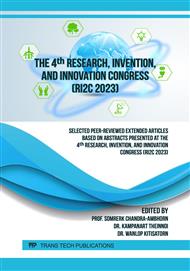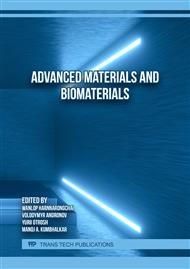[1]
C. Scully, & R. Shotts, Mouth ulcers and other causes of orofacial soreness and pain, Bmj. 321 (2000) 162-165.
DOI: 10.1136/bmj.321.7254.162
Google Scholar
[2]
X. Kong, J. Fu, K. Shao, L. Wang, X. Lan, & J. Shi, Biomimetic hydrogel for rapid and scar-free healing of skin wounds inspired by the healing process of oral mucosa, Acta biomaterialia. 100 (2019) 255-269.
DOI: 10.1016/j.actbio.2019.10.011
Google Scholar
[3]
N. Boochangkool, Advanced wound dressing, TMJ. 17 (2017) 402-407.
Google Scholar
[4]
Hydrogels on https://archive.lib.cmu.ac.th/full/T/2552/chem0352pj_ch1.pdf
Google Scholar
[5]
K. Nešović, A. Janković, T. Radetić, A. Perić-Grujić, M. Vukašinović-Sekulić, V. Kojić, .. & V. Mišković-Stanković, Poly (vinyl alcohol)/chitosan hydrogels with electrochemically synthesized silver nanoparticles for wound dressing applications, Journal of Electrochemical Science and Engineering. 10 (2020) 185-198.
DOI: 10.5599/jese.732
Google Scholar
[6]
Y. TASSANAPUKDEE, & K. Songsrirote, The Synthesis of Chitosan-Based Hydrogel Using Microwave-Assisted Irradiation For Adsorption of Heavy Metal Ions, (Doctoral dissertation, Srinakharinwirot University). (2020)
Google Scholar
[7]
Y. Zhou, Y. Zhao, L. Wang, L. Xu, M. Zhai, &S. Wei, Radiation synthesis and characterization of nanosilver/gelatin/carboxymethyl chitosan hydrogel, Radiation Physics and Chemistry. 81 (2012) 553-560.
DOI: 10.1016/j.radphyschem.2012.01.014
Google Scholar
[8]
Synthesis of Silver Nanoparticles Reduced with the Plant Extract in Lysimachia Genus and Their Antibacterial Activity on http://scijournal.kku.ac.th/files/Vol_45_No_1_P_34-52.pdf
Google Scholar
[9]
A. Gupta, S.M. Briffa, S. Swingler, H. Gibson, V. Kannappan, G. Adamus, ... &I. Radecka, Synthesis of silver nanoparticles using curcumin-cyclodextrins loaded into bacterial cellulose- based hydrogels for wound dressing applications, Biomacromolecules. 21 (2020) 1802-1811.
DOI: 10.1021/acs.biomac.9b01724
Google Scholar
[10]
W. Yang, J.I. Peter, R.O. Williams III, Inhaled nanoparticles–a current review, International Journal of Pharmaceutics. 356 (2008) 239-247.
Google Scholar
[11]
A.R. Shet, P. Ghose, L. Patil, & V. Hombalimath, A preliminary study on green synthesis and antibarterial activity of silver nanoparticles, International Journal of Current Biotechnology. 3 (2015) 1-6.
Google Scholar
[12]
S. Suwannakul, S. Wacharanad, & P. Chaibenjawong, Rapid green synthesis of silver nanoparticles and evaluation of their properties for oral disease therapy, Songklanakarin Journal of Science & Technology. 40 (2018).
Google Scholar
[13]
D. Alfarraj, M.M. Al Khulaifi, & N. Moubayed, Correlation of phenolic content and antibacterial activity of dried lime extracts against human pathogens, Biomedical Research. 29 (2018) 0970-9380.
DOI: 10.4066/biomedicalresearch.29-18-828
Google Scholar
[14]
S.A. Al-Thabaiti, Z. Khan, & N. Manzoor, Biosynthesis of silver nanoparticles and Its antibacterialand antifungal activities towards Gram-positive, Gram-negative bacterial strains and different species of Candida fungus, Bioprocess and biosystems engineering. 38 (2015) 1773-1781.
DOI: 10.1007/s00449-015-1418-3
Google Scholar
[15]
Silver nanoparticles on sutir.sut.ac.th:8080/sutir/bitstream/123456789/8176/2/Fulltext.pdf
Google Scholar
[16]
R. Geethalakshmi, D.V.L. Sarada, Gold and silver nanoparticles from Trianthema decandra: synthesis, characterization, and antimicrobial properties, International Journal of Nanomedicine. 7 (2012) 5375–5384.
DOI: 10.2147/ijn.s36516
Google Scholar
[17]
P. Ngamplang, N. Lertmahasub, Nanoparticles-Based Hydrogel for Antibacterial Applications, Bachelor degrees thesis, B.A., King Mongkut's University of Technology North Bangkok, Bangkok. (2020)
Google Scholar
[18]
S. Ortelli, Tailoring properties and functionalities of TiO2 and Ag nanoparticles involved in surfaces engineering processes. (2015).
Google Scholar
[19]
T. Wang, M. Turhan, & S. Gunasekaran, Selected properties of pH‐sensitive, biodegradable chitosan–poly (vinyl alcohol) hydrogel, Polymer International. 53 (2004) 911-918.
DOI: 10.1002/pi.1461
Google Scholar
[20]
H.S. Mansur, E.D.S. Costa Jr, A.A. Mansur, & E.F. Barbosa-Stancioli, Cytocompatibility evaluation in cell-culture systems of chemically crosslinked chitosan/PVA hydrogels, Materials Science and Engineering: C. 29 (2009) 1574-1583.
DOI: 10.1016/j.msec.2008.12.012
Google Scholar
[21]
S. Agnihotri, S. Mukherji, & S. Mukherji, Antimicrobial chitosan–PVA hydrogel as a nanoreactor and immobilizing matrix for silver nanoparticles, Applied Nanoscience. 2 (2012) 179-188.
DOI: 10.1007/s13204-012-0080-1
Google Scholar



